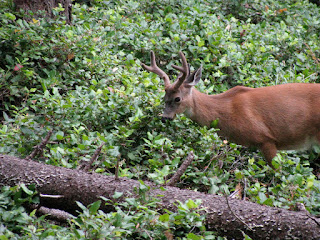Part of the problem is the Hollywood-spawned mentality that humans and wildlife interact peacefully, as long as you approach the animals with good intentions. Somehow, the wild animals are supposed to understand that you mean them no harm — all you want to do is cuddle.
Boy, that's a load of trash. Let me put it this way, if someone wandered into my home uninvited, the last thing I'm going to think is that he wants to cuddle. Well the same thing applies to wildlife. That's their home you're wandering into.
Survival as a wild animal demands that these critters live in "red alert" mode all the time. The minute they let down their guard, they become someone's lunch. This becomes the most important concept in their life, so when a threat appears they will either run away or fight for their life.
Then you show up with your camera and snacks, hoping to feed one of these cute creatures. Next thing you know, you're in a hospital bed with injuries or perhaps disease you received as a result of your adventure.
So here's the deal — If you encounter a wild animal:
- Keep your distance — there is no valid reason to approach a wild animal, no matter how cute they are.
- Even small critters like chipmunks and raccoons can carry disease that can be easily transferred to humans (plague, rabies, virus and bacteria).
- Bears are predators who sometimes injure or kill humans during encounters. If you are going into bear country, know about it beforehand. Maintain a constant watch for evidence of bears. Keep all food and garbage in bear-proof containers. If you encounter a bear, back away slowly, keeping an eye on the bear. Do not run, as that will spark an attack response. Just calmly move out of the area, so the bear doesn’t consider you a threat.
- Cougars — they will stalk humans, follow them for miles, and take them down from behind when least expected. Best not to travel alone in cougar country. Always be prepared to defend yourself in an attack, using a knife, stick, rock or whatever you have. Never try to run. Face the cougar, make yourself look big and dangerous. Don’t loose your feet during the battle.
- Moose, elk, deer, bison — all are dangerous to humans, so keep your distance. If you are approached or attacked by big game, keep something solid (tree, boulder) between you and the animal until it loses interest in you and goes away. You can’t outrun them, so don’t even try unless you have a vehicle or building very close at hand that you can scramble into.

Most animals are faster and stronger than I am even when they seem friendly so allow for that.
ReplyDeleteAnd I hate coons coming into my space for the cat food.
Hiking and camping over the years: no even potentially dangerous close encounters. Of course, I've never spent much time in bear country, either. My only potentially dangerous close encounter with a wild animal was in a supposedly fenced off picnic area in a state wildlife preserve. Family outing. Concrete slab picnic tables and benches. Bison bull wandered in. . between us and our car. Had my wife and the child sitting on the bull's side of the table slide under and up onto the side away from the bull. All of us slowly rotated so that our legs were on the outside (farthest away from the bull) of the concrete bench and then just sat quietly, each of us (my wife and I) holding a child so we could move quickly, if needed, to keep the table (or its remains, if it came to that *heh*) between us and the bull. He snorted and shook himself "at" us a couple of times. Browsed a while and moved off. In hindsight, was pretty cool. Notified the park ranger and he said they knew where the fence break probably was. In subsequent visits, I checked any fenced area first.
ReplyDelete